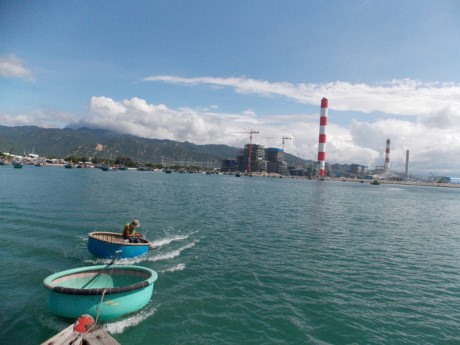 Op-Ed
Op-Ed

Earlier this month, the Environment Minister said “we can’t dump waste into the sea.”
 |
Thu Vân
Earlier this month, the Environment Minister said “we can’t dump waste into the sea.”
More than understandable, given all the facts and dire warnings that were brought to the fore on World Oceans Day (June 8).
And no Vietnamese will ever forget what happened in April last year when steel maker Formosa discharged untreated effluents into the sea, killing millions of fish and disrupting, if not destroying, the livelihoods of hundreds of thousands of people living on the country’s central coast.
We can safely say we have had direct experience of sea pollution and its impacts.
Then what are we to make of the environment ministry approving last week a proposal by the Vĩnh Tân Thermal Power Plant to dump nearly one million cubic meters of industrial waste into the sea off southern Bình Thuận Province?
The approval came seven months after the proposal was made in November last year. It also came in the face of protests by many experts and environmental scientists.
What gives? Is the ministry not listening to the minister?
Wasn’t it the minister who substantiated his anti-dumping statement by saying that after a series of environmental “incidents”, aka disasters in Việt Nam, “our environment’s endurance has come to its limit?”
Maybe there’s something we don’t know.
The Vĩnh Tân management board claims this industrial waste is just “natural sediment’’ excavated from the surrounding seabed to make room for large cargo ships to bring in coal.
The waste cannot be treated on land because there would not be enough space, and there are concerns it could cause saline intrusion, it says.
According to the plan, the waste that “does not contain toxic or radioactive substances exceeding Vietnamese standards” will be transported in barges and dumped into a 30-hectare sea area in Vĩnh Tân Commune, 8km away from Hòn Cau Marine Protected Area (MPA).
However, scientists, local residents and officials of the protected area have said the dumping of dredged material will degrade the precious marine ecosystems of Hòn Cau MPA.
Hòn Cau MPA comprises 12,500 hectares that are home to 234 coral species, 324 fish species, 119 molluscs, 32 echinoderms and 46 crustaceans and reptiles, many of which have important economic values like the ornate spiny lobster, green sea turtles and hawksbill sea turtles.
The area also has an abundant, diverse marine plant system, especially sea-grass and algae, and provides beaches for sea turtles to nest during their breeding season.
Nguyễn Tác An, vice chairman of the Vietnam Association of Marine Science and Technology and former director of Nha Trang Oceanography Institute, said the damage will be hard to measure.
Scientifically, the dumping of a tonne of waste into the sea would affect a large area – even if the waste is non-toxic, he said.
Creatures that rely on sight to survive could die if the water is disturbed, and though they might be very tiny, they play a very important role in the ecosystem, An said.
“The consequences would be forever, not just a few decades,” he stressed.
On Tuesday, Deputy Environment Minister Nguyễn Linh Ngọc told the media that the dumping would not affect the marine ecosystem at all, because the sea area where the waste would be dumped had nothing but sand.
However, he also admitted that there is no certainty that the dumping will be a risk-free process. It will have to be supervised and the Vĩnh Tân Plant would have to pay compensation for any damage caused, he said.
An rejected the nothing-but-sand claim, saying that any seabed area will have living creatures, and once they are disturbed, it would seriously affect the whole ecosystem.
When both officials and experts have repeatedly said that most environmental penalties in Việt Nam are not strong enough to act as deterrents, the management board of the plant is unlikely to lose sleep over the “threat” of having to compensate for damages caused.
If this approval holds, it stands to reason that more such dumping would follow.
Ongoing damage
The development of coal power in Bình Thuận Province is already posing a serious threat to the Hòn Cau ecosystem by the transportation activities and waste discharge of the Vĩnh Tân 2 Plant, the dredging plan for Vĩnh Tân 1 Plant, and the future impacts of the entire five-plant complex are not likely to be mild, to put it mildly.
In April 2015, thousands of people had blockaded National Highway No 1A for many hours, stopping traffic, to complain about coal dust and cinder from the power complex, especially from the Vĩnh Tân No 2.
In December 2015, the coal dust spread to other plants under construction. Soil dumped along National Highway 1A has reportedly disrupted locals’ lives.
The Bình Thuận Department of Natural Resources and Environment has warned that the amount of cinder and ash will increase when Vĩnh Tân power plants 1, 3 and 4 are put into operation.
A brief review is in order here. The Bình Thuận Province’s People’s Committee, in a document sent to the Ministry of Agriculture and Rural Development (MARD) in 2015, admitted that the projects of the Vĩnh Tân Power Complex would encroach the Hòn Cau MPA by as much as 1,000 hectares.
The committee proposed that MARD reduces the MPA by 1,000 hectares. The agriculture ministry rejected the proposal, saying Hòn Cau contains tropical marine ecosystems with high biodiversity, and shrinking it would seriously affect the coral population which survives on a two kilometers long area with nearly 234 types of coral, sea-grass and other rare animals and plants.
But, surprisingly, in February this year, it was announced that up to 10,000 clusters or blocks of corals had been relocated to the Hòn Cau Marine Protected Area to facilitate the dredging of passages for building the plant.
Although it has been reported that the corals were growing well in the new environment, marine experts are not convinced.
They say the relocation of corals will lead to serious impacts on the marine environment, reduce the reproduction of marine creatures in the area and affect fishing.
Many high-ranking officials have repeatedly said that economic development will no longer be pursued at the expense of the natural environment.
Such statements cannot be deployed as rhetorical screen to cover environmentally unsustainable actions, now and in the future.
Last year, the Bình Thuận provincial Department of Natural Resources and the Environment, anticipating the serious impact on the Hòn Cau MPA caused by the waste discharge, asked the investor to find another solution.
Is it too late now?
Is praying all we can do, or don’t we have a prayer?




